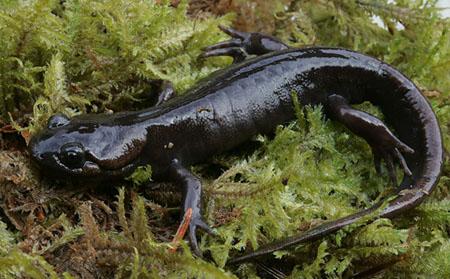Salamander - Northwestern
Mud Puppy Scientific Name: Abystoma gracile
Tue, 15th July, 2025 - 10:04 pm GMT
Sponsor Ads:

Alternative Name
Mud Puppy Scientific Name: Abystoma gracileBasic Info
At maturity, a Northwestern Salamander may be about 8.5 inches in length, and its body is usually quite stocky. The Northwestern Salamander is generally dark colored, and shades of black, gray, or brown are common. In some areas, little flecks of white or cream colors may be evident on the topside, as well. Generally, the underside is a lighter brown color. The oval parotid glands of the Northwestern Salamander are in evidence behind their eyes, and may be a lighter color than the rest of the salamander. Costal grooves are also quite obvious, as is a bumpy gland on the upper side of the tail. Some Northwestern Salamanders will remain in an aquatic state and can actually live out their lives and reproduce in this "undeveloped" manner. This is known as neoteny. The vents of males tend to be more swollen than those of females, especially during the breeding season.
Health
Breeding Northwestern Salamanders usually breed at some time between January and August, depending upon the elevation they are living in. Generally, more northerly species will also breed later in the year. The courtship involves the male rubbing the female's nose with his chin. He will then lay a spermatophore and continue to rub her body until she takes it into her cloaca. Males may produce up to 30 of these spermatophores each breeding season. The eggs are laid in large clusters, and generally there are between 40 and 150 eggs in each cluster. The eggs are the size of pinheads and are brown and clearly defined. Generally, Northwestern Salamanders will attach their egg clusters to vegetation about 5 to 12 inches below the surface of water. The eggs take about a year to develop, and in higher altitudes may require two years. Generally, they will need about two more years to become sexually mature.Habitat
Most often, Northwestern Salamanders make their homes in permanent or semi-permanent watercourses. They seem to prefer waters with slow currents or fairly still waters like ponds or lakes.Behavior
The Northwestern Salamander is a fascinating creature that has habits similar to those of some toads. These unique amphibians are quite secretive, and observing one in the wild can be a very interesting experience. Northwestern Salamanders are nocturnal creatures. During the day and even throughout most of the night when they are active they remain hidden. Generally, they are buried beneath debris on the forest floor like leaves or rotting logs. They eat insects like slugs and earthworms. In captivity they are reported to do quite well with crickets. Northwestern Salamanders are generally quite docile. When alarmed, Northwestern Salamanders have a unique self-defense mechanism similar to that of toads. They can squirt a milky poison from glands behind their eyes and on their tails. They have been used in environmental testing as an indicator of water pollution, which causes harm to their larvae. Northwestern Salamanders appear to be sensitive to heavy metal pollution in their water, which can result in high mortality and deformation rates.Origin
Pacific NorthwestHistory
Northwestern Salamanders may be found at elevations of up to 1,000 feet. Generally, they inhabit the Pacific Northwest of North America, ranging from Alaska down to northern California in the United States. They are also found in British Columbia and Canada. Some people call Northwestern Salamanders Mud Puppies or Brown SalamandersCommon Foods
feeds primarily on insects, earthworms, small rodents, small animals.Sponsor Ads:
"When there's public debate and mass hysteria, that's when the patches roll in." -- Michael Meeks (GNOME Developer)
Salamander - Northwestern
Coded by: BGID® | ALL RIGHTS RESERVED Copyright © 2000-2025
Disclaimer | Privacy | Report Errors / Contact | Credits


 Why haven't we as a collective earth met with aliens yet?
Why haven't we as a collective earth met with aliens yet?  World EcoSystem - Biodiversity Changes - Who is on board and who isn
World EcoSystem - Biodiversity Changes - Who is on board and who isn  Homosexual behavior stems from the mind or genetics?
Homosexual behavior stems from the mind or genetics?  The Best Text Adventure You Will Ever Play! The official site:
The Best Text Adventure You Will Ever Play! The official site:  Mouthwash - Mouthrinse - Mouth Sores - Healing Infections - Gingivitis
Mouthwash - Mouthrinse - Mouth Sores - Healing Infections - Gingivitis  Treatment for Depression
Treatment for Depression  Ultra radical and violent Islamist group that even rivals Al Qaeda
Ultra radical and violent Islamist group that even rivals Al Qaeda  An idea to have teachers who want to carry guns to school undergo some level of police training will be left up to local school districts and police departments.
An idea to have teachers who want to carry guns to school undergo some level of police training will be left up to local school districts and police departments.